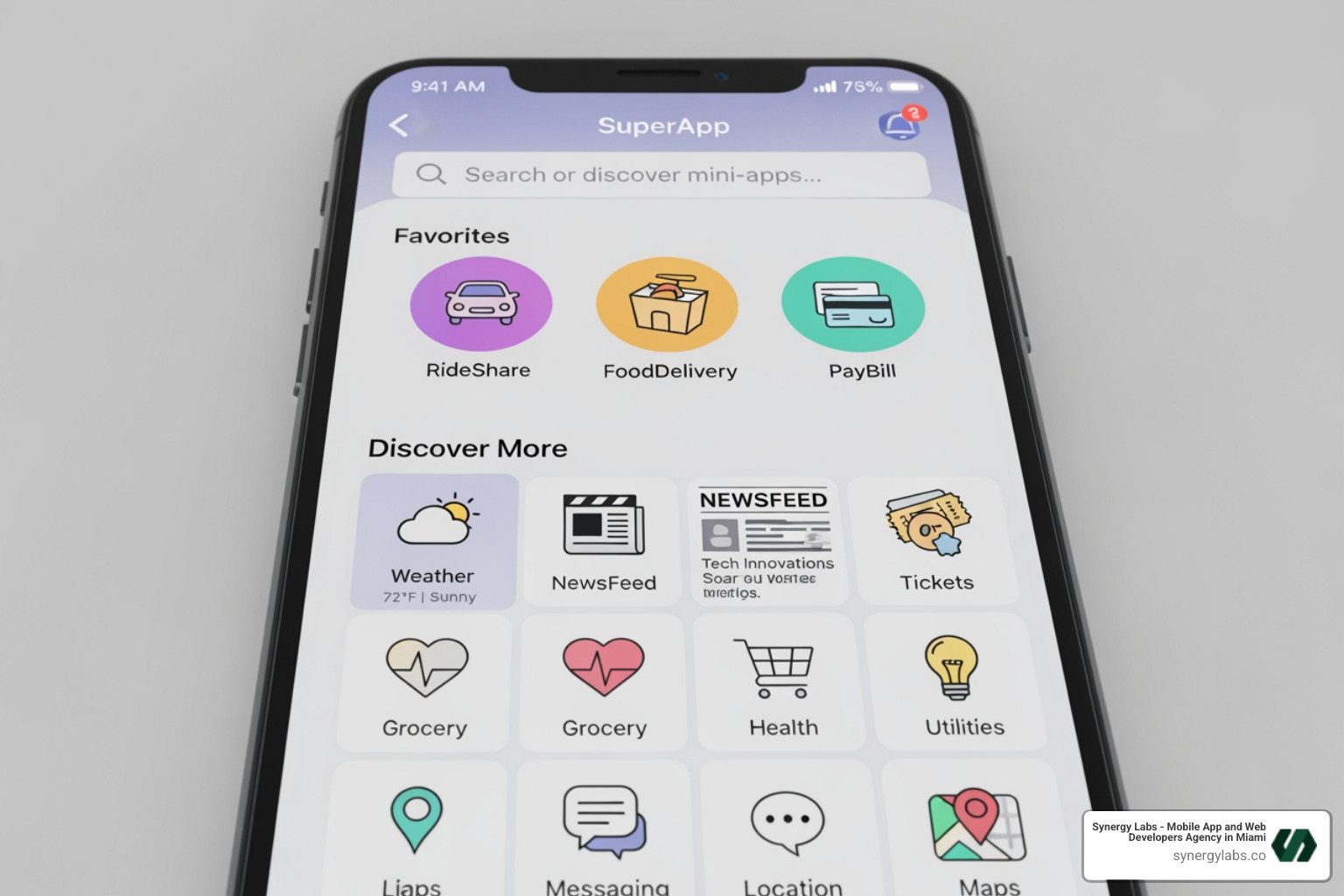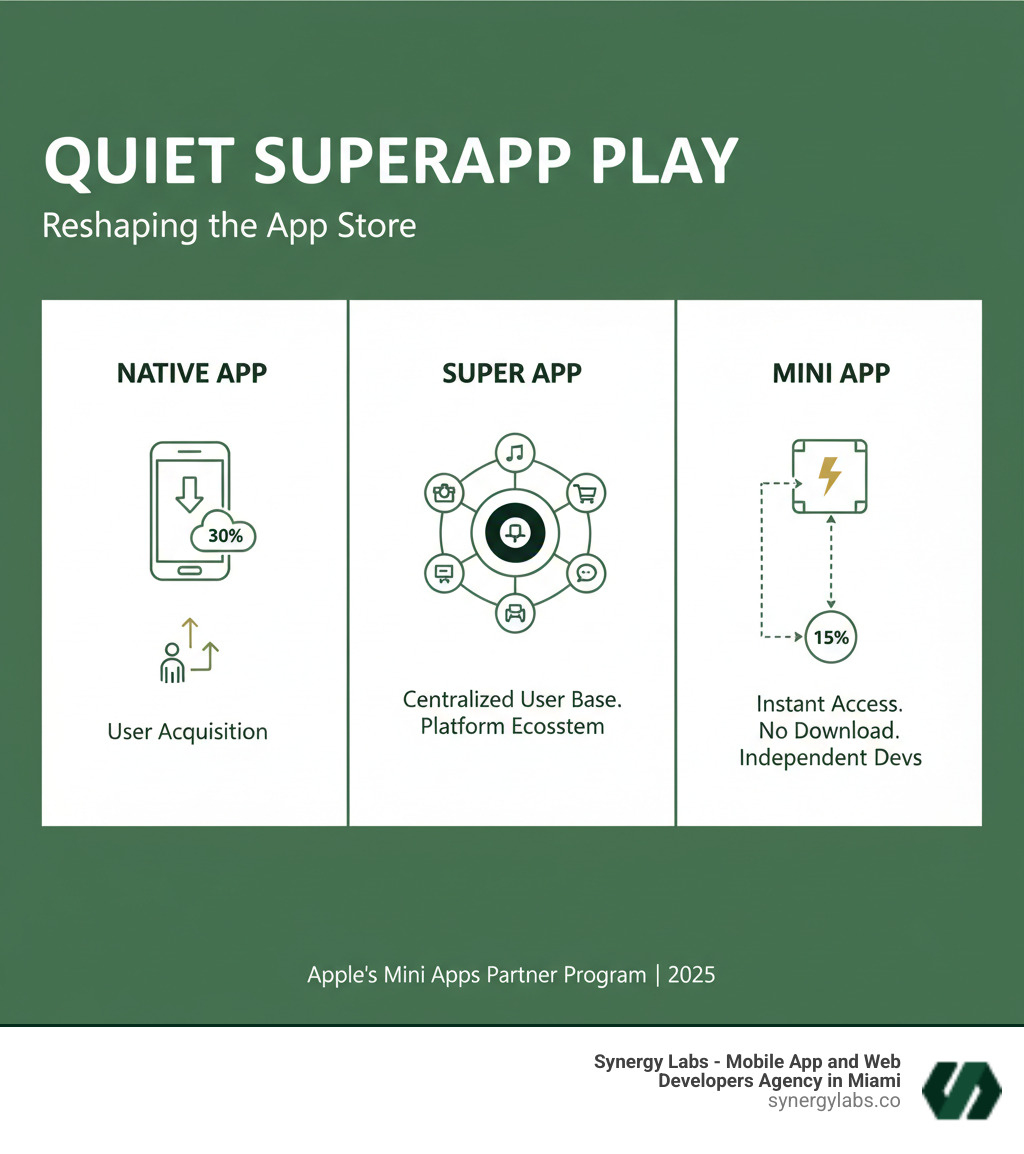S'associer à une agence de premier plan
Schedulea meeting via the form here and
we'll connect you directly with our director of product-no sales involved.
Prefer to talk now ?
Give us call at + 1 (645) 444 - 1069

This program turns high-traffic apps into potential super apps, creating platforms that host multiple mini-programs.

Apple's Mini Apps Partner Program: The Quiet Superapp Play That Could Reshape the App Store is a significant shift in mobile app distribution. Here's a quick overview:
Launched recently, this program turns high-traffic apps into potential super apps, creating platforms that host multiple mini-programs. For developers, this changes the distribution game. Instead of fighting for downloads, you can embed your mini-app inside an established app with millions of users. The 85% revenue share makes this financially attractive, especially for lightweight tools.
The timing is ideal for AI-powered micro-apps like calculators and planners, which fit this format perfectly. Apple has built the infrastructure for AI-native tools to thrive within larger applications, complete with built-in commerce.
At Synergy Labs, we've seen how distribution advantages define a product's success. This program is a strategic opportunity that ambitious founders should leverage early. The coming years will likely see a wave of mini-apps that blur the lines between standalone products and integrated ecosystems.

Let's break down what Apple's Mini Apps Partner Program: The Quiet Superapp Play That Could Reshape the App Store means for developers and users. Instead of leaving your current app to download another for a specific task like booking a ride or ordering food. This program lets you access these services directly within a "host" app.
Developers can build lightweight HTML and JavaScript mini-apps that function as integrated experiences, not just embedded web pages. They get full access to Apple's commerce and age verification systems. This is Apple's answer to the super app trend, allowing users to access multiple services from a single interface, like a budgeting tool inside a banking app.
The key is the monetization shift. Developers can reach huge audiences without the usual download friction, solving the difficult problem of distribution. As we've noted in the Top 5 Trends in Mobile App Development, this represents a fundamental change in how software is built and distributed.
The main incentive for developers is that Apple is only taking a 15% commission on purchases within qualifying mini-apps, half its standard 30% fee. This isn't just generosity; it's a strategic signal that Apple wants this ecosystem to thrive.
For developers, keeping 85 cents on the dollar instead of 70 can be the difference between profitability and breaking even. This reduced rate is especially appealing for high-volume, low-margin services like utilities, calculators, and AI-powered micro-apps that are perfect for the mini-app format.
The financial incentive also levels the playing field for indie developers, who can leverage an existing app's user base instead of funding a large marketing campaign. This opens up new App Monetization Strategies for smaller teams.
Before building a mini-app, you need to know the rules. Most importantly, the mini-app must be from an independent developer, not controlled by the host app's company. This rule prevents large platforms from using the program to avoid the 30% commission and encourages third-party innovation.
Technically, mini-apps are built with HTML and JavaScript frameworks, lowering the barrier to entry for web developers. You must also integrate two key Apple APIs:
These requirements balance openness with the quality control and security iOS users expect. Proper API integration is crucial, as errors are among the Common Mobile App Development Mistakes and How to Avoid Them. For full technical details, see Apple's official announcement: Introducing the App Store Mini Apps Partner Program.

The "super app" phenomenon, where users perform dozens of daily tasks within a single application, has long dominated Asian markets. A prime example is a digital lifestyle platform for everything from messaging and payments to booking appointments.
Western markets have lacked a true equivalent, with users juggling multiple single-purpose apps. Apple's Mini Apps Partner Program: The Quiet Superapp Play That Could Reshape the App Store is Apple's strategic answer to this global trend. By creating a framework for mini-apps to exist within larger host apps, Apple is building the infrastructure for Western super apps to emerge.
This move extends Apple's ecosystem control beyond standalone apps, positioning it to capture revenue from a new category of integrated mobile experiences and ensuring iOS remains at the forefront of mobile's future.
By offering a 15% commission rate, Apple incentivizes high-traffic apps to become super app hosts. A popular social media or e-commerce platform now has a financial reason to host third-party services, legitimizing the super app model in the West.
This transforms successful apps into distribution channels, which is a game-changer for developers struggling with user acquisition. The concept of distribution arbitrage returns; developers can embed their mini-app inside an app with an existing user base, gaining instant access to millions of customers without download friction.
This evolution in app traction, as discussed in The Future of Mobile Apps: Nikita Bier Explodes Social Media Trends & App Innovation, is a major shift. At Synergy Labs, we're excited to help clients leverage this new distribution model, whether as a host or a mini-app developer.
The app ecosystem's power dynamics are shifting. High-traffic app owners now control potential platforms. The participation of pioneers in the mini-app space validates Apple's model and signals its viability.
Owners of popular apps can now open a new revenue stream by hosting third-party mini-apps and taking a revenue share. This makes their app more valuable and sticky without in-house development costs. For mini-app developers, the focus shifts from user acquisition to strategic partnerships with host apps that align with their target audience.
This evolution highlights the importance of strategic positioning, a key reason Why Your Business Needs a Mobile App in 2024. Understanding this shift early provides a significant competitive advantage.

Apple's Mini Apps Partner Program: The Quiet Superapp Play That Could Reshape the App Store is more than a policy update; it's a rethinking of the mobile app model. The current App Store, a marketplace of standalone "island" apps, is evolving into an interconnected, modular ecosystem.
We're moving from monolithic apps to lightweight, purpose-built mini-apps that integrate into larger frameworks. This shift represents the "unbundling and re-bundling" of the app ecosystem. Functions that once required separate downloads can now be re-bundled under one roof, like a travel super app hosting mini-apps for flights, hotels, and car rentals.
For developers, this changes everything. The focus shifts from building standalone apps and fighting for visibility to creating focused mini-apps that thrive within existing platforms. The new mantra is "build it where they already are." Understanding The App Store in 2025: 5 Growth Moves That Work is essential for navigating this new landscape.
This program creates distinct opportunities for all developers. For indie developers and small studios, it's a game-changer. Instead of battling for visibility in a crowded App Store, they can integrate their mini-app into a popular host app and gain instant access to millions of users. This reduced friction allows them to focus on product development over marketing.
Large developers with high-traffic apps can become powerful platforms, hosting mini-apps for photo editing, event planning, or financial management. This expansion occurs without the overhead of in-house development, and host apps can earn a revenue share, creating new income streams while making their core product stickier.
This also fosters an Embedded SaaS model, where specialized tools live inside larger applications. Think of an AI content generator within a social media scheduler. These are full mini-apps by independent developers, generating revenue and enhancing the host app.
Navigating these strategic decisions is where Synergy Labs excels. The modular ecosystem highlights Why Businesses Should Choose Boutique App Development Agencies for Scalable Solutions, as success requires both technical skill and strategic partnership planning.
For the end user, the primary benefit is convenience. Instead of juggling dozens of apps, you can accomplish multiple tasks within a few super apps. This integrated experience simplifies your digital life, and the reduced install friction makes trying new services easier since no download is required.
However, there are potential drawbacks. One is relocated clutter; a poorly organized super app can be as overwhelming as a messy home screen. A more serious concern is security and privacy. The lines of data access and sharing become blurrier between the mini-app, host app, and Apple. Users must remain vigilant about permissions.
Apple addresses this with strict API requirements for commerce and age verification, but the model's success ultimately depends on maintaining an exceptional The Importance of User Experience (UX) in Mobile App Design and robust security. If done right, it's a massive leap in convenience; if done wrong, it could become a frustrating and insecure experience.

The timing of Apple's Mini Apps Partner Program: The Quiet Superapp Play That Could Reshape the App Store aligns perfectly with the current AI revolution. Emerging AI tools—like smart calculators, personalized planners, and other LLM-powered utilities—are naturally lightweight and purpose-built, making them ideal candidates for the mini-app format.
Apple has provided the infrastructure, a built-in commerce layer, and a 15% commission rate, creating the perfect environment for AI-native utilities to thrive within larger apps. This allows developers to create unique, functional AI tools like mood journals or recipe suggesters that can live inside apps with millions of users. As we explore AI-Powered Personalization: Enhancing User Experience in Mobile Applications, this program opens new pathways for creating value in context, offering users intelligent assistance right when they need it.
This program enables a truly AI-native user experience, where intelligent tools are seamlessly woven into everyday apps. Imagine an AI coaching mini-app in your fitness app or an AI valuation bot in a real estate app—integrated and ready to use without a separate download.
Built-in commerce makes monetization straightforward through subscriptions or one-time purchases, removing the friction between finding and using an AI tool. This blurs the line between product, content, and utility. What matters is that the tool works and adds value.
As we've explored in AI-Native UX: Why the Next Great Products Won't Look Like Apps, the future is contextual, intelligent, and embedded. Apple's program provides the infrastructure to make this vision a scalable reality.
However, this platform shift has risks. For Apple, implementation challenges are significant. Ensuring quality and security across thousands of third-party mini-apps requires a robust and scalable review process to maintain user trust.
Developers face platform dependency. Going all-in on mini-apps means being tied to Apple's ecosystem, a dynamic we've explored in The Fragile Relationship Between Developers and Platforms: Why Trust Matters. Apple must prove itself a reliable long-term partner.
Competitively, other major platforms are watching. The race to dominate the embedded app space in the West is on, and we can expect other companies to launch similar frameworks. For developers, the key is to deliver value while maintaining flexibility.
At Synergy Labs, we help clients steer these platform shifts, balancing risk with opportunity to ensure success.
Let's tackle the most common questions about this new program.
The two main benefits are financial and distributional. First, the reduced 15% commission rate (down from 30%) means developers keep 85% of their revenue, a significant boost for indie developers and startups.
Second, and perhaps more importantly, is access to existing user bases. Instead of costly user acquisition campaigns, your mini-app can be instantly available to millions of users within a high-traffic host app. This distribution arbitrage lowers the barrier to entry, allowing you to test ideas and scale more efficiently.
No, the program is designed for high-traffic apps with substantial user bases, such as major social networks or e-commerce platforms. These apps become platforms themselves, responsible for integrating third-party mini-apps and ensuring a smooth user experience.
In return, host apps can share in the revenue generated by the mini-apps they feature. This creates a new monetization stream for the host while giving mini-app developers access to a large audience.
This is a crucial distinction. While mini-apps use HTML and JavaScript, they offer deeper integration than a simple web view. They are not isolated web pages; they are part of a formal, monetizable framework.
Mini-apps leverage native Apple's commerce APIs for secure payments and the Declared Age Range API for age verification. This creates a seamless, integrated user experience backed by Apple's security and oversight, unlike a clunky, disconnected embedded browser. Users may not even realize they've transitioned from the host app to a mini-app.
Apple's Mini Apps Partner Program: The Quiet Superapp Play That Could Reshape the App Store signals a fundamental reimagining of mobile software. The era of fragmented, siloed apps is giving way to integrated, modular experiences within broader ecosystems. The App Store is evolving from a catalog of downloads into a network of interconnected services.
This modular universe opens new doors. For developers, it means instant distribution and lower user acquisition costs by embedding tools directly into high-traffic apps. For businesses, it offers a chance to become a platform or find a new, efficient path to market. The unbundling and re-bundling of app functionality creates opportunities for everyone.
Navigating this platform shift requires an expert partner. At Synergy Labs, we specialize in helping businesses build innovative, scalable applications that thrive during transitions like this. We understand the technical requirements, strategic implications, and creative possibilities of this new era.
Whether you want to become a super app host or have a brilliant mini-app concept, our senior talent can bring your vision to life. The modular app universe is here, and the opportunities are enormous. Explore our top app development services to see how we can help you build for this exciting new landscape. Let's create something remarkable together.

Pour commencer, rien de plus simple ! Il vous suffit de nous contacter en nous faisant part de votre idée à l'aide de notre formulaire de contact. L'un des membres de notre équipe vous répondra dans un délai d'un jour ouvrable par courriel ou par téléphone pour discuter de votre projet en détail. Nous sommes impatients de vous aider à concrétiser votre vision !
Choisir SynergyLabs, c'est s'associer à une agence de développement d'applications mobiles de premier plan qui donne la priorité à vos besoins. Notre équipe, entièrement basée aux États-Unis, se consacre à la livraison d'applications de haute qualité, évolutives et multiplateformes, rapidement et à un prix abordable. Nous mettons l'accent sur un service personnalisé, en veillant à ce que vous travailliez directement avec des talents chevronnés tout au long de votre projet. Notre engagement envers l'innovation, la satisfaction du client et la communication transparente nous distingue des autres agences. Avec SynergyLabs, vous pouvez être sûr que votre vision sera concrétisée avec expertise et soin.
Nous lançons généralement les applications dans un délai de 6 à 8 semaines, en fonction de la complexité et des fonctionnalités de votre projet. Notre processus de développement rationalisé vous permet de commercialiser rapidement votre application tout en bénéficiant d'un produit de haute qualité.
Notre méthode de développement multiplateforme nous permet de créer simultanément des applications web et mobiles. Cela signifie que votre application mobile sera disponible à la fois sur iOS et Android, assurant une large portée et une expérience utilisateur transparente sur tous les appareils. Notre approche vous permet d'économiser du temps et des ressources tout en maximisant le potentiel de votre application.
Chez SynergyLabs, nous utilisons une variété de langages de programmation et de frameworks pour répondre au mieux aux besoins de votre projet. Pour le développement multiplateforme, nous utilisons Flutter ou Flutterflow, ce qui nous permet de prendre en charge efficacement le web, Android et iOS avec une seule base de code - idéal pour les projets avec des budgets serrés. Pour les applications natives, nous utilisons Swift pour iOS et Kotlin pour les applications Android.




Pour les applications web, nous combinons des frameworks de mise en page frontale comme Ant Design, ou Material Design avec React. Pour le backend, nous utilisons généralement Laravel ou Yii2 pour les projets monolithiques, et Node.js pour les architectures sans serveur.






En outre, nous pouvons prendre en charge diverses technologies, notamment Microsoft Azure, Google Cloud, Firebase, Amazon Web Services (AWS), React Native, Docker, NGINX, Apache, et bien plus encore. Cet ensemble de compétences diversifiées nous permet de fournir des solutions robustes et évolutives adaptées à vos besoins spécifiques.








La sécurité est une priorité absolue pour nous. Nous mettons en œuvre des mesures de sécurité conformes aux normes de l'industrie, notamment le cryptage des données, des pratiques de codage sécurisées et des audits de sécurité réguliers, afin de protéger votre application et les données de vos utilisateurs.
Oui, nous offrons une assistance, une maintenance et des mises à jour continues pour votre application. Après l'achèvement de votre projet, vous recevrez jusqu'à 4 semaines de maintenance gratuite pour vous assurer que tout se passe bien. Après cette période, nous vous proposons des options d'assistance continue flexibles adaptées à vos besoins, afin que vous puissiez vous concentrer sur le développement de votre activité pendant que nous nous occupons de la maintenance et des mises à jour de votre application.